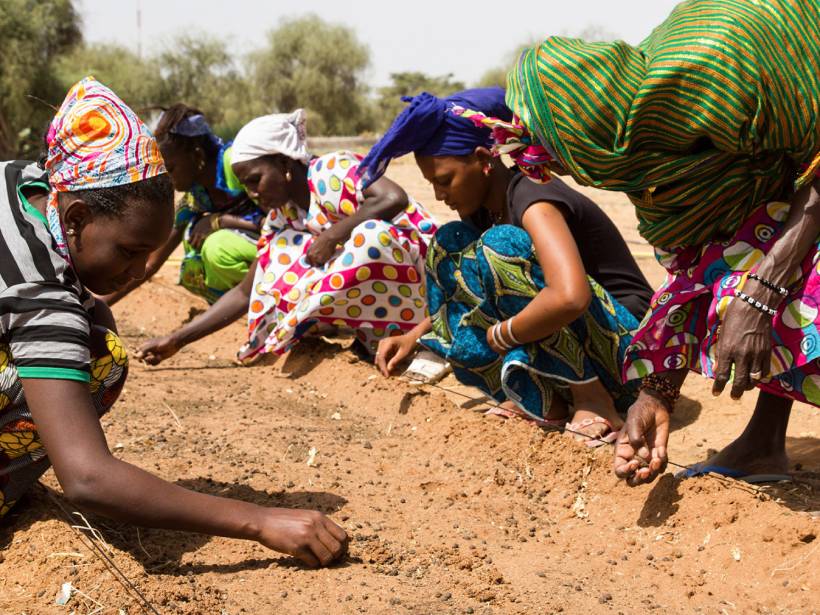Two of the most extreme effects of climate change are desertification and land degradation, phenomena that may displace some 50 million people in this decade, according to the United Nations. To help address these issues in one of the world’s most vulnerable regions, a reforestation project in Africa known as the Great Green Wall (GGW) recently got a big shot in the arm with $14.32 billion in pledges from donors. Backers, consisting of international development banks and national governments, are hoping the project can help halt the advance of the Sahara desert in the northern Sahel.
The United Nations defines desertification as “the persistent degradation of dryland ecosystems by climate change and mainly human activities.” The consequences of desertification are not only ecological but also social, economic, and political: As land becomes degraded, people are dragged into poverty, forcing some to migrate.
Saving the Sahel
Land degradation could have profound consequences for the 250 million people living in 10 countries across the Sahel, a band of tropical and subtropical grasslands and savannas spanning northern Africa from Senegal to Djibouti. “Without the Great Green Wall, the Sahel region as we know it may disappear,” African Development Bank president Akinwumi Adesina told a donor conference earlier this year.
Launched in 2007 as an initiative of the African Union, the GGW is an ambitious attempt to cultivate an 8,000-kilometer-long, 15-kilometer-wide barrier across the Sahel by planting trees, grasslands, and other vegetation. Aside from restoring 100 million hectares of degraded land across the Sahel and neighboring Sahara, the project aims to create 10 million jobs.
“When you consider that 80% of Africa’s economy depends on a climate-sensitive natural resource base like rain-fed, subsistence agriculture, then you start to understand the implications of land degradation on the workforce here,” said James Bigila, a spokesperson for the United Nations Convention to Combat Desertification (UNCCD).
Between 2007 and 2018, nearly 18 million hectares of land were restored, over 350,000 jobs were created, and around $90 million was generated through GGW activities, according to Bigila, who added that the project is contributing to 15 of the 17 U.N. Sustainable Development Goals. Some of these results, along with footage of Sahel residents planting trees and grasses, can be seen in a documentary produced by Fernando Meirelles and starring Malian musician Inna Modja.

Studies Target the Greening Trend
The Sahel suffered a series of droughts and famines between the 1960s and 1990s. It has been identified as a “hotspot for climate change” by the U.N. Intergovernmental Panel on Climate Change, which predicts that temperatures in Africa, particularly in arid regions, will rise faster than the global land average.
However, research has also suggested that parts of the Sahel have actually been greening in recent decades because of increased rainfall and other factors. This phenomenon has been the subject of debate. Barron Joseph Orr, lead scientist for UNCCD, said that although satellite imagery shows expanded green areas since the 1980s, there is general agreement among land users that even though rains may have recovered, the quality of the land and its vegetation has not always returned to what it was before the droughts.
“Greening does not necessary equate with more healthy land,” said Orr. “Moreover, the greening trend is not uniform, and the ‘where’ of greening matters.”
Against that backdrop, the Sahel and the GGW have been the subject of a spate of recent scientific studies, with different views of the project. A 2019 study in Regional Environmental Change describes the GGW as a “potential game-changer in the Sahel” due to such factors as pan-African coordination, significant investment, scientific research informing the process from an early stage, and a consensus that business-as-usual development efforts are ineffective.
A 2020 analysis in Land Degradation and Development took a clear-eyed look at the practicality and sustainability of the GGW. It noted that without specifying a crop or vegetation type, 43.5% of the Sahel and 25.6% of the proposed GGW region, respectively, “are not feasible for sustainable planting, that is, under rainfed and natural land fertility conditions” and that investing in a greenbelt east of longitude 10°E is “risky without supplementary irrigation.” Orr pointed out that there are major efforts to improve the arid adaptiveness of crops, trees, and grasses “in a way that is increasingly full systems–based,” noting work by the International Center for Agricultural Research in the Dry Areas (ICARDA) and World Agroforestry.
Overcoming Challenges
Even with its new financial pledges, the GGW faces numerous obstacles. For one, it’s only about 15% underway and will require at least $33 billion to meet its objectives of creating “a natural wonder” across the African continent.
“The Great Green Wall is one piece in the puzzle in providing genuine alternatives for people increasingly seeking ‘a way out’ of abject hopelessness and desperate poverty.”
Other challenges include monitoring and tracking progress, political instability and conflict in and among participating nations, and population growth putting pressure on natural resources. Most GGW countries face challenges in establishing governance and project structures for attracting funding as well as technical hurdles and survival rates of tree planting projects, said Bigila.
But supporters of the project said that greening the land is something that can and must be achieved.
“Ignoring the plight of jobless young people in sub-Saharan Africa is a recipe for political instability and global insecurity,” said Bigila. “The Great Green Wall is one piece in the puzzle in providing genuine alternatives for people increasingly seeking ‘a way out’ of abject hopelessness and desperate poverty.”
—Tim Hornyak (@robotopia), Science Writer
Citation:
Hornyak, T. (2021), New funding fortifies Africa’s Great Green Wall, Eos, 102, https://doi.org/10.1029/2021EO155594. Published on 09 March 2021.
Text © 2021. The authors. CC BY-NC-ND 3.0
Except where otherwise noted, images are subject to copyright. Any reuse without express permission from the copyright owner is prohibited.

